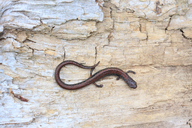|
Thorius pulmonaris Taylor, 1940
| family: Plethodontidae subfamily: Hemidactyliinae genus: Thorius |
 © 2015 Sean Michael Rovito (1 of 11) |
|
|
Country distribution from AmphibiaWeb's database: Mexico
Author: Jean Raffaëlli Thorius pulmonaris Taylor, 1940 Cohabite avec T. narisovalis, mais les deux espèces ne vivent pas en syntopie, et T. pulmonaris vit à plus basse altitude. Plus petite taille. 2,7 cm SVL (6,3 cm). Queue allongée, plus grande que le reste du corps. Narine de très grande taille, ovale, presque aussi grande que l’œil, museau allongé chez le mâle, doigts et orteils grands. Gris bleuâtre dorsalement, brun clair à blanchâtre ventralement, moucheture blanche sur les flancs, pas de bande dorsale évidente. Une tache blanchâtre sur la paupière inférieure. Région de Cerro San Felipe (centre de l’Oaxaca) et zones d’altitude au sud et à l’ouest de la ville d’Oaxaca, entre 2 100 et 2 500 m, dans les feuilles mortes à terre en forêts mixtes pins/chênes dégradées de la Sierra Aloapaneca. 100 km2. EN. Peut-être présente dans le parc national Benito Juarez.
It lives in sympatry but not syntopy with T. narisovali, the latter lives at lower altitude. The size of pulmonaris is also smaller. 2.7cm SVL (6.3cm). The tail is elongated, bigger than the rest of the body. The nostril is really big, oval, and is almost as big as the eye. The snout is elongated in males, the fingers and toes are big. Dorsal parts are blueish grey, ventral parts are light brown to white. Flanks show a white freckle. The is no obvious dorsal stripe. There is a white spot on the inferior eyelid. Habitat & Range: Cerro San Felipe (central Oaxaca) and high altitude areas south and west of the city of Oaxaca, between 2100 and 2500m ASL. It lives in dead leaves, in altered mixed pine/oak forests of the Sierra Aloapaneca. 100Km2. Conservation:
Endangered. It may be present in Benito Juarez national park. Feedback or comments about this page.
Citation: AmphibiaWeb. 2025. <https://amphibiaweb.org> University of California, Berkeley, CA, USA. Accessed 23 May 2025. AmphibiaWeb's policy on data use. |


 Raffaëlli Account
Raffaëlli Account Map of Life
Map of Life
 ENGLISH TRANSLATION - Julian Wittische
ENGLISH TRANSLATION - Julian Wittische